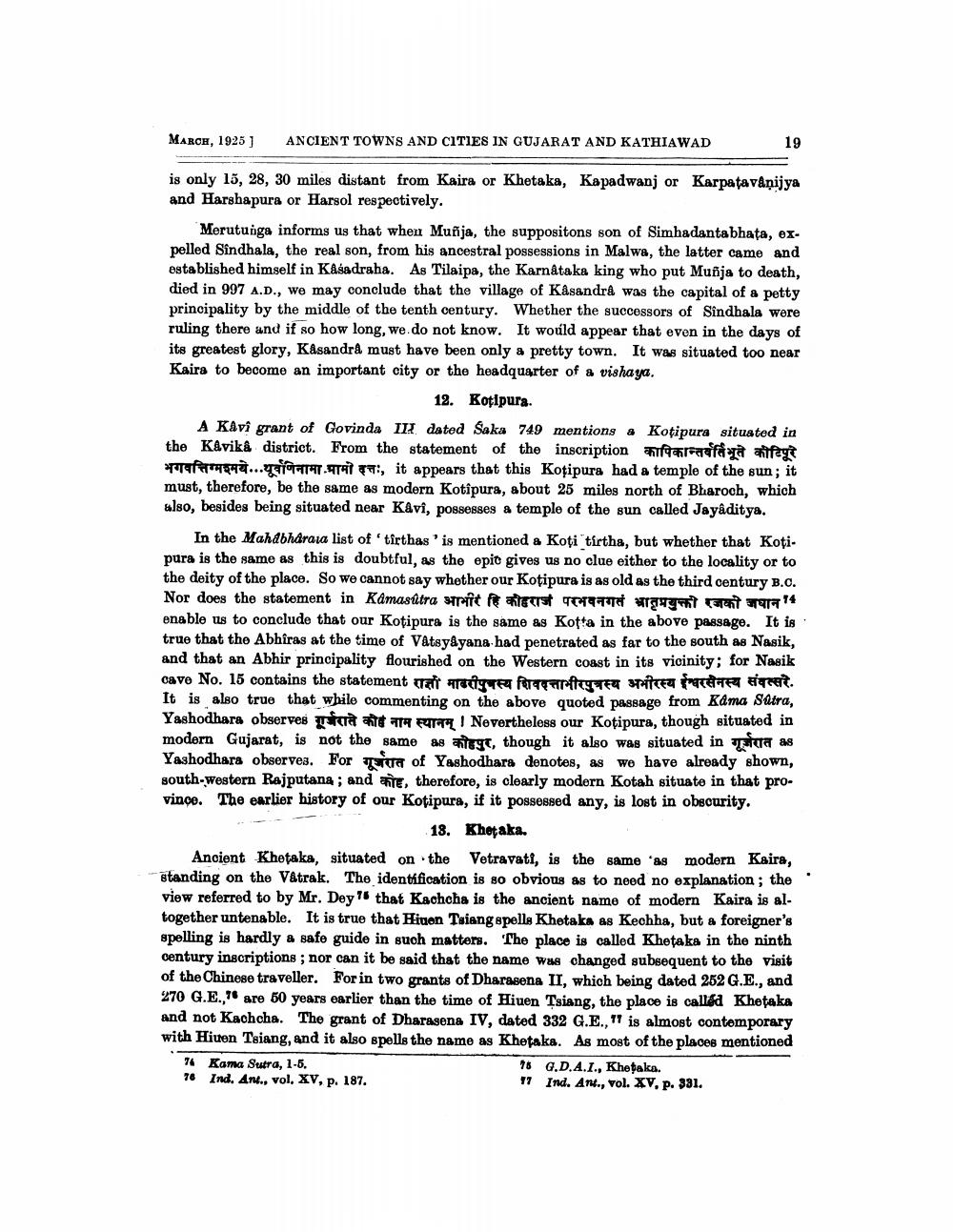________________
MARCH, 1925)
ANCIENT TOWNS AND CITIES IN GUJARAT AND KATHIAWAD
19
is only 15, 28, 30 miles distant from Kaira or Khetaka, Kapadwanj or Karpatavanijya and Harghapura or Harsol respectively.
Merutunga informs us that when Muñja, the suppositons son of Simhadantabhata, expelled Sindhala, the real son, from his ancestral possessions in Malwa, the latter came and established himself in Kasadraha. As Tilaipa, the Karnataka king who put Muñja to death, died in 997 A.D., we may conclude that the village of Kasandra was the capital of a petty principality by the middle of the tenth century. Whether the successors of Sindhala were ruling there and if so how long, we do not know. It would appear that even in the days of its greatest glory, Kasandra must have been only a pretty town. It was situated too near Kaira to become an important city or the headquarter of a vishaya.
12. Kotipura. A Kavî grant of Govinda II dated Saka 749 mentions « Kotipura situated in the Kåvikâ district. From the statement of the inscription fraafiye arifet preferate... AT TATT, it appears that this Koțipura had a temple of the sun; it must, therefore, be the same as modern Kotipura, about 25 miles north of Bharooh, which also, besides being situated near Kavi, possesses a temple of the sun called Jayaditya.
In the Mahabharaja list of tirthas ' is mentioned a Koti tirths, but whether that Koti. pura is the same as this is doubtful, as the epit gives us no clue either to the locality or to the deity of the place. So we cannot say whether our Kotipura is as old as the third century B.C. Nor does the statement in Kamasutra prift erst T779 wigsmit t ra14 enable us to conclude that our Kotipura is the same as Kotta in the above passage. It is true that the Abhîras at the time of Vatsyâyana had penetrated as far to the south as Nasik, and that an Abhir principality flourished on the Western coast in its vicinity; for Nasik cave No. 15 contains the statement TET Frederea for f ree spitsee TR . It is also true that while commenting on the above quoted passage from Kama Sutra, Yashodhara observes ca att ATA FATTE I Nevertheless our Kotipura, though situated in modern Gujarat, is not the same as iegt, though it also was situated in Tara as Yashodhara observes. For rentre of Yashodhara denotes, as we have already shown, south-western Rajputana ; and therefore, is clearly modern Kotah situate in that province. The earlier history of our Kotipura, if it possessed any, is lost in obscurity.
18. Khetaka. Ancient Khetaka, situated on the Vetravati, is the same 'as modern Kaira, standing on the Vátrak. The identification is so obvious as to need no explanation; the view referred to by Mr. Dey TS that Kachcha is the ancient name of modern Kaira is altogether untenable. It is true that Higen Tsiang spells Khetaka as Kechha, but a foreigner's spelling is hardly a safe guide in such matters. The place is called Khetaka in the ninth century inscriptions ; nor can it be said that the name was changed subsequent to the visit of the Chinese traveller. For in two grants of Dharasena II, which being dated 252 G.E., and 270 G.E.T6 are 50 years earlier than the time of Hiuen Tsiang, the place is called Khetaka and not Kachcha. The grant of Dharasena IV, dated 332 G.E.," is almost contemporary with Hiuen Tsiang, and it also spells the name as Khetaka. As most of the places mentioned 74 Kama Sutra, 1-5.
70 G.D.A.1., Khetaka. 76 Ind. Ant., vol. XV, p. 187.
11 Ind. Ant., vol. XV. p. 331.




